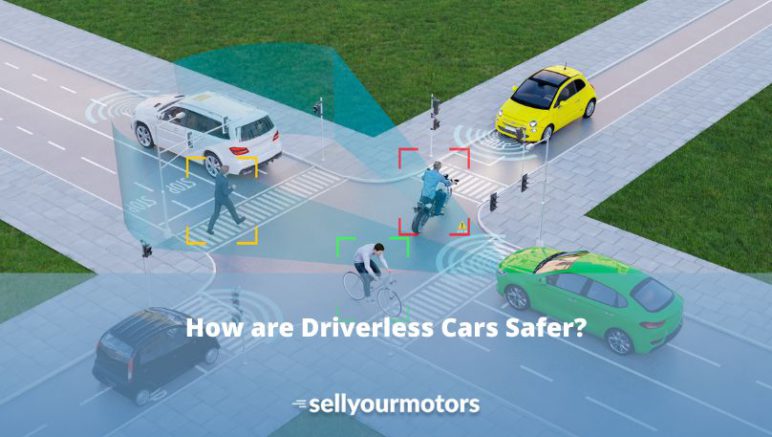The safety of autonomous vehicles has been a major concern for potential users and regulators alike. Even the smallest of accidents can have devastating consequences when there is no driver to take control. But how can we build a safer car? Users will only trust driverless cars when they know they’re safer than human drivers. After all, 94% of crashes are attributed to human error, and 90% of collisions involve some type of distracted driving. These stats make it difficult to sell the idea of handing our lives over to an artificial intelligence that isn’t yet capable of handling every driving situation with ease. In this blog post, we will discuss 5 ways in which autonomous vehicles are safer than conventional cars, as well as some concerns that need addressing before these vehicles become commonplace on the road.
How are Driverless Cars Safer: Voice Assistants as a Safer Alternative to Touch Screen Controls
As autonomous vehicles become more advanced and integrated into our daily lives, we’ll need to find ways to navigate the often complex interfaces without taking our eyes off the road. While it might be easy enough to glance over to a knob or button to change the volume or station, a touch screen or keyboard presents an even greater risk. Voice assistants make perfect sense in this context, especially with the rise of smart homes and voice control becoming more popular. We can use the same voice commands we would in our homes to perform the same functions inside our autonomous vehicles. However, what happens when we need to take additional actions while behind the wheel? To avoid even the risk of driver distraction, voice assistants will need to become even more advanced. New software and hardware developments will be needed to allow these assistants to recognize and understand complex instructions while in motion. When we’re able to give more nuanced instructions like “please navigate to the nearest Starbucks,” we’ll be that much safer behind the wheel.
How are Driverless Cars Safer: Enhanced Vision Software to See Around the Corner
As autonomous vehicles become more common, their ability to sense danger around every corner is critical. Unfortunately, the current vision systems used by most driverless cars can only see what’s directly in front of them. This means if there are no obstacles or hazards in the car’s path, the vehicle is able to proceed. But if there is something blocking the path — a pedestrian, another car, or a pothole — the vehicle won’t be able to see it. As a result, autonomous vehicles will come to a stop, often waiting for the obstruction to clear before proceeding again. Humans can easily see around corners, and scientists are working on applying this same ability to driverless cars. The technology is called “multiplexed imaging” and uses a single camera to capture many images at once. Then, the camera processes these images using computer vision to create a 3-D image of what’s around the corner. This technology would allow autonomous vehicles to see pedestrians or other cars that may be hidden around a corner. Multiplexed imaging would help vehicles avoid accidents, especially at intersections where many accidents occur because drivers don’t see all of the pedestrians and cyclists crossing the street. This technology isn’t fully developed yet, but it’s on the way. Scientists are working to make multiplexed imaging smaller and more efficient so that it can fit inside driverless cars.
How are Driverless Cars Safer: Parallel Processors to Handle Multiple Tasks at Once
One of the most important aspects of driverless cars is that they can perform many tasks at once. While we’re driving, we often navigate, talk on the phone, and listen to music. This can often lead to distracted driving and a lack of focus on the road. With an AI-driven system, autonomous vehicles can perform these tasks without taking their attention away from driving. This isn’t a new concept, but one that is already in use in many industries. Think of an AI as a supercomputer that can perform many complex operations at once. By having all of the necessary systems and functions of the car pre-programmed, the AI can handle multiple tasks at once. This will not only increase the functionality and usability of the vehicle, but also improve safety by keeping the driver focused on the road. No longer will drivers need to use their navigation system to figure out the best route. They’ll also be able to make phone calls, play music, set reminders, and log their driving hours with a simple voice command. This will not only make autonomous vehicles more user-friendly, but also safer by minimizing the amount of time drivers are interacting with their vehicle.
How are Driverless Cars Safer: Automated Emergency Braking
Another safety feature that both human and AI drivers will benefit from is automated emergency braking (AEB). This system is designed to detect when the car is about to hit something, such as a pedestrian or another car. Once the system recognizes the potential accident, it will attempt to slow the car down using the brakes. Unfortunately, AEB is not standard in all cars, as many drivers disable the system because they don’t trust it. This is understandable, as the system often doesn’t work as intended, causing more accidents than it prevents. But with an AI system, automatic braking becomes safer and more effective. A driverless car will know when an accident is imminent and take the appropriate action. It can use various sensors, including the AEB, to identify potential hazards and react appropriately. In the unlikely event that the AEB fails, the rest of the car’s systems will also stop the vehicle from colliding with other objects. This system doesn’t completely eliminate the risk of accidents, but it does make us safer. Driverless cars will be able to stop more quickly than a human driver, minimizing the damage of the accident.
How are Driverless Cars Safer: Autonomous Vehicles Are Already Safer Than Humans
While many of these features haven’t been implemented in driverless cars yet, they will be soon. As autonomous vehicles are tested on more and more roads, scientists and engineers can better understand their strengths and weaknesses. Once they have a better understanding of what works and what doesn’t, they’ll be able to make adjustments. This will lead to safer vehicles that can handle hazardous road conditions better than humans can. According to the most recent statistics, human drivers are responsible for 94% of all accidents. Driverless cars can reduce this number significantly by removing human error from the equation. The algorithms used by autonomous vehicles are designed to make rational decisions, whether the system is fully online or communicating with a remote human operator. Humans, on the other hand, are increasingly distracted and irrational behind the wheel, making them dangerous for both themselves and others on the road. For example, we know that 94% of all accidents are caused by human error, including distraction, drunk driving, and fatigue. A fully autonomous car won’t get distracted, drive drunk, or fall asleep behind the wheel. This makes autonomous vehicles significantly safer than conventional cars.
Conclusion
When it comes to the safety of autonomous vehicles, there is a lot of skepticism. However, the technology is continually improving and will become safer as the testing and research continues. Autonomous vehicles will help reduce traffic accidents and fatalities, and they’ll also improve the quality of life for many people who can’t drive or are unable to do so. We’ll only be able to make autonomous vehicles a reality if we are able to address these concerns and prove to the public that they are a safer choice. This can only be done through continued research and development. As engineers continue to push the boundaries of what these vehicles are capable of, we’ll see autonomous vehicles become safer and more accessible than ever before.
Sell Your Motors
Car buying specialists are your best bet when you want to sell your car fast for a fair price. At Sell Your Motors we pride ourselves for being transparent and completing the whole car buying process in only 30 minutes!







